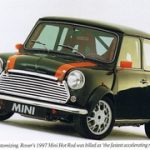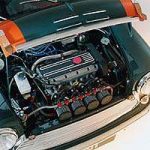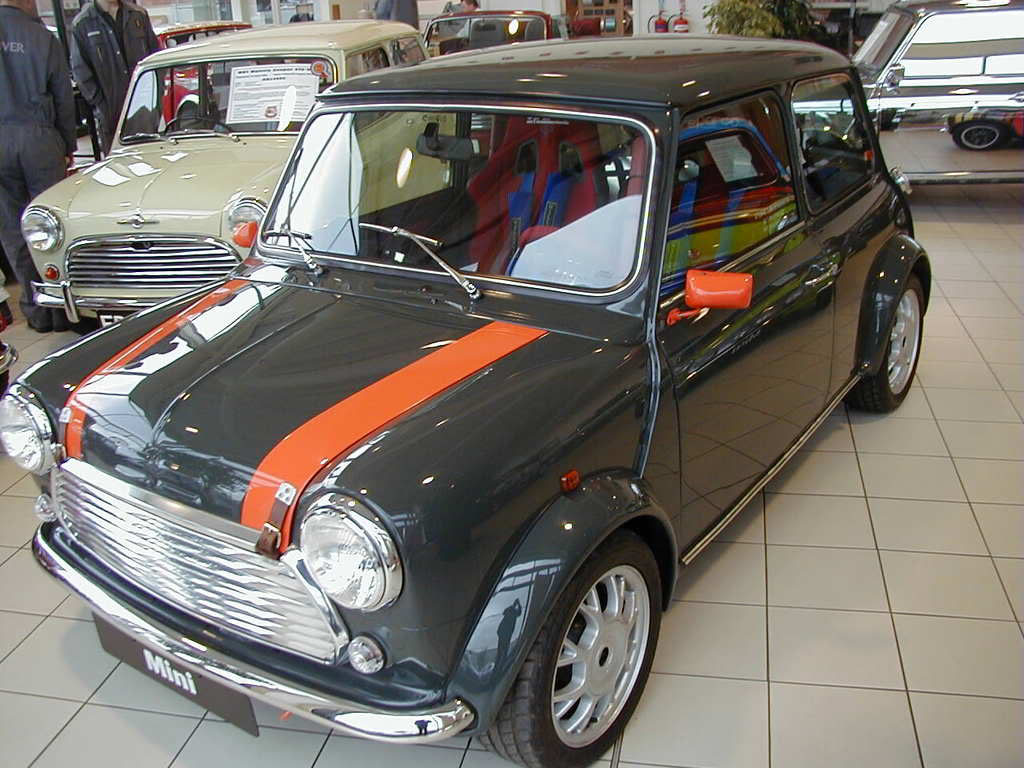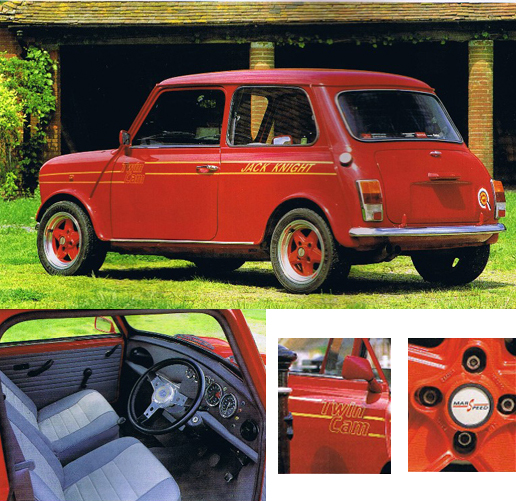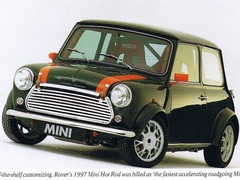 この ミニ ホット ロッド(Mini Hot Rod)は 英国マーズスピード社/ジャックナイト社が ドイツBMW社の社長に 依頼され マーズスピード・ウィンチェスター工場内で 請負い製作したものです。完成後、この車は 1997年のドイツ・フランクフルト ショー、スイス・ジュネーブ ショー、英国・アールスコート ショーで BMW/ローバー社のプロトタイプ・ニューミニのブース内のガラスケースに入れられて展示されました。
この ミニ ホット ロッド(Mini Hot Rod)は 英国マーズスピード社/ジャックナイト社が ドイツBMW社の社長に 依頼され マーズスピード・ウィンチェスター工場内で 請負い製作したものです。完成後、この車は 1997年のドイツ・フランクフルト ショー、スイス・ジュネーブ ショー、英国・アールスコート ショーで BMW/ローバー社のプロトタイプ・ニューミニのブース内のガラスケースに入れられて展示されました。
下記にご紹介する資料は既にネット上からは削除されていますが、http://show.goodtech.co.uk/mini/frankfurt/specs.htmlから引用したもので、ローバー社とBMW社の公式資料の記載です。
翻訳文
Mini Hot Rod
HOT RODを開発する目的は、最速のMiniを作ることである。これまでは、大型でパワーのあるエンジンを用いるというアプローチが採られており、例えばV8エンジンが使われたケースもあった。Rover社のエンジニアの中には高性能でコンパクトなKV6エンジンの搭載を主張した者もいたが、最終的に我々は従来のミニと同様、Aシリーズ・エンジンを搭載することに決定した。
エンジン
我々はJACK KNIGHT DEVELOPMENT(ジャックナイト・デベロップメント)に出向きエンジンを開発することにした。なぜなら、既に排気量を1380ccにまでボア・アップしたエンジンとともに、16バルブ・ツインカム・ヘッドの試験検討がなされていたためである。これを採用することで、エンジンはコンパクトなまま大きなパワーを出せるようになった。そして、ミニの小さなエンジン・ベイにそのまま納められたため、車のラインを崩さずに済んだのである。実際、ボンネットを開けた際に分かる違いとしては、Weber Alphaフュエル・インジェクション・システムのエア・インテーク用ルーバーが4つあることくらいだった。なお、搭載前に測定した結果、エンジン出力は161馬力だった。
ギアボックス
高出力のエンジンには、高性能なギアボックスが必要である。まず、ギアボックスには、ストレート・ギアの5速「ドッグ」ボックスを採用した。トルク・ステアを防ぐ為に、同じ長さのハーフ・シャフトを用い、プレート・タイプのノン・スリップ・デフを採用した。さらに、ドライバーの負担を軽減するため、クィック・ギア・ステアリングを追加した。
ブレーキ
後輪にはアルミ製ドラム・ブレーキが、前輪にはカーボン・メタリック・パッド付き4ポット・アルミ製キャリパーが装着されており、十分な制動性能を得られるようにした。
内装
この車は快適さよりもスピード重視で造られたため、通常の内装は取り除かれており、後部座席の部分にはアルミ製パネルが装着されている。シートはSparco(スパルコ)のリクライニング・シート 4点式シート・ベルト付きで、6ポイント・ロール・ケージも装着されている。更に安全性を高める為、消火器が自動車内部とエンジン・ベイに設置されている。また、方向指示器やワイパーなどの操作系はドライバーの負担を軽減するように配置されている。
ペイント・ワーク
塗装は1970年代のBRM F1カーをモデルにした。正確な色合いにするため、PPGペイント社のJohn Euanが Donnington Collectionを訪問して、スキャナを使って色の測定を行い、同社のコンピュータ・システムを用いることで、同車のグリーンのボディにオレンジ色のストライプを忠実に再現した。
パフォーマンス
英国に戻ってからの計測になるが、我々の予想ではスタートから5秒以内に60mph(時速60マイル=約96キロ)に達するものと思われる。
Mini Hot Rod
The objective for the Hot Rod was to develop the quickest Mini ever. There have been many conversions which develop huge amounts of power by using other engines, even V8s in some instances! While some members of the team toyed with the idea of putting Rover’s extremely effective and compact KV6 engine in the car, we decided to stay with the A Series unit synonymous with the Mini.
Engine
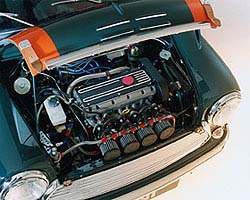 We turned to Jack Knight Developments to develop the engine, as the much-tried and tested 16 valve twin cam head, along with boring the capacity of the engine out to 1,380cc. This does a very good job of developing large amounts of horsepower while the unit’s compact dimensions mean that the entire engine fits into the Mini’s diminutive engine bay without spoiling the lines of the car. In fact the only outward signs of anything unusual under the bonnet are four louvres which act as air intakes for the Weber Alpha fuel injection system.
We turned to Jack Knight Developments to develop the engine, as the much-tried and tested 16 valve twin cam head, along with boring the capacity of the engine out to 1,380cc. This does a very good job of developing large amounts of horsepower while the unit’s compact dimensions mean that the entire engine fits into the Mini’s diminutive engine bay without spoiling the lines of the car. In fact the only outward signs of anything unusual under the bonnet are four louvres which act as air intakes for the Weber Alpha fuel injection system.
Before being installed into the car the engine was measured producing 161 bhp.
Gearbox
Putting this much power through the drivetrain demands high performance equipment. Firstly the gearbox is a five speed ‘dog’ box with straight-cut gears. Power goes out to the wheels via equal length half-shafts to prevent torque-steer, and a plate-type limited slip differential helps put the power down on the road.
To finish off a quick gearchange assembly was added to enable the driver to change gear with the flick of a wrist.
Brakes
Alloy drums are fitted to the rear, while at the front four-pot alloy callipers are fitted with carbon metallic pads to ensure that the whole ensemble comes to a more than adequate halt.
Interior
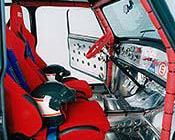 The car is built for speed rather than comfort, and all the standard trimmings were stripped out, including the rear seats, to be replaced with alloy panels. Sparco reclining bucket seats are provided for the front occupants together with four-point seat belts, and a six-point roll cage. For additional safety a fully-plumbed-in fire extinguisher is installed for the car interior and engine bay.
The car is built for speed rather than comfort, and all the standard trimmings were stripped out, including the rear seats, to be replaced with alloy panels. Sparco reclining bucket seats are provided for the front occupants together with four-point seat belts, and a six-point roll cage. For additional safety a fully-plumbed-in fire extinguisher is installed for the car interior and engine bay.
All minor controls, such as indicators and wipers, are located on the steering wheel, so that the driver doesn’t have to lift his hands off the wheel unnecessarily.
Paintwork
The paint scheme is inspired by a 1970s BRM Formula 1 car. To ensure accuracy John Euan from PPG paints visited the Donnington Collection and used a scanner to measure the precise shade of green used on the BRM cars. This was then fed into PPG’s computer system, which produced the precise shade of green, as well as the paint for the distinctive orange stripes.
Performance
We aim to try out the acceleration of the car on its return to the UK. Our projections show that the car will take less than 5 seconds for the dash from 0 to 60 mph.

